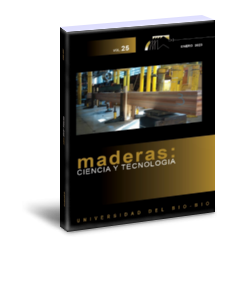Variations in decay resistance of cryptomeria fortunei
DOI:
https://doi.org/10.4067/s0718-221x2023000100413Keywords:
Brown rot, Cryptomeria fortunei, decay resistance, extractives, heartwood, Robinia pseudoacacia, white rotAbstract
Cryptomeria fortunei has been widely planted in many cities in southern China. Eventually some of this material may be utilized for timber, but there are relatively few studies of durability of this resource. There is also some question as to whether Cryptomeria fortunei is a synonym for Cryptomeria japonica or Japanese cedar (Sugi). Evaluating the durability of the Chinese resource will help ensure that the decay resistance of this urban plantation resource is properly categorized. The decay resistance of Cryptomeria fortunei wood was assessed in soil block and agar block tests against Trametes versicolor, Gloeophyllum trabeum and Rhodonia placenta. Hot water and ethanol extractive contents of the heartwood were determined on sections from various distances above ground and then FTIR spectroscopy was used to characterize the wood before and after fungal exposure. Weight losses in sapwood were consistent with the minimal decay resistance of this portion of the wood. Inner and outer heartwood weight losses were more variable suggesting that the heartwood of this species would be considered to be only moderately durable. Extractives were weakly correlated with decay resistance. FTIR results were more variable, although they suggested heavier attack of lignin components by the brown rot fungi. The results suggest that Cryptomeria fortunei would need to be protected from the weather unless supplemental preservative treatments were applied.
Downloads
References
American Wood Protection Association. AWPA. 2017. Standard method of testing wood preservatives by laboratory soil-block cultures. Standard E10-16. AWPA Book of Standards. Birmingham, Alabama.
Cappellazzi, J.; Morrell, J.J. 2016 Decay resistance of Cryptomeria japonica. Unpublished report, Department of Wood Science & Engineering, Oregon State University, Corvallis, OR., USA.
Faix, O. 1992. Fourier Transform Infrared Spectroscopy. In Methods in Lignin Chemistry. pp.233-241. Lin S.Y.; Dence C.W. (eds). Springer Series in Wood Science. Springer, Berlin, Heidelberg. https://doi.org/10.1007/978-3-642-74065-7_16.
Freitag, C.M.; Morrell, J.J. 2006. Decay resistance of Cryptomeria fortunei Hooibrenk. Unpublished report, Department of Wood Science and Engineering, Oregon State University, Corvallis, OR., USA.
Latorraca, J.V.F.; Dunisch, O.; Koch, G. 2011. Chemical composition and natural durability of juvenile and mature heartwood of Robinia pseudoacacia L. Anais Acad Brasil Ci 83(3): 1059-1068. https://doi.org/10.1590/S0001-37652011005000016
Lipeh, S.; Schimleck, L.R.; Morrell, J.J. 2019. Determination of carvacrol content in Alaska yellow cedar (Callitropsis nootkatensis) extractives. BioResources 14(4): 9928-9944. https://bioresources.cnr.ncsu.edu/resources/determination-of-carvacrol-content-in-alaska-yellow-cedar-callitropsis-nootkatensis-extractives/
Matsuoka, S.; Amemiya, S.; Shoji, Y.; Inoue, M.; Abe, H.; Naito, K. 1970. Stake test at Asakawa Experiment Forest (3), The natural durability of some woods. Bulletin of Forestry and Forest Products Research Institute 232: 109-135.
Morita, I.D.; Hidaka, T.; Yatagi, M. 1997. Antifungal compounds of the extracts of Yakusugi (Cryptomeria japonica D.Don). Wood Preservation 23:11-19.
Okitani, T.; Takabe, K.; Takahashi, M. 1999. The role of extractives involved in the natural durability of domestic softwood. Wood Research: bulletin of the Wood Research Institute Kyoto University 86: 51-52. http://hdl.handle.net/2433/53166
Pandey, K.K.; Pitman, A. 2003. FTIR studies of the changes in wood chemistry following decay by brown-rot and white-rot fungi. Int Biodeterior Biodegrad 52(3): 151-160. https://doi.org/10.1016/S0964-8305(03)00052-0
Pollet, C.; Jourez, B.; Hbert, J. 2003. Natural durability of black locust (Robinia pseudoacacia L) wood grown in Wallonia, Belgium. Can J For Res 38(6): 1275-1289. https://doi.org/10.1139/X07-244
Scheffer, T.C.; Cowling, E.B. 1966. Natural decay resistance of wood to microbial deterioration. Annual Rev Phytopath 4:147-170. https://doi.org/10.1146/annurev.py.04.090166.001051
Scheffer, T.C.; Morrell, J.J. 1998. Natural durability of wood: A worldwide checklist of species. Oregon State University, Corvallis, OR. Research Contribution 22, Forest Research Laboratory. https://ir.library.oregonstate.edu/concern/technical_reports/dz010r37p
Taylor, A.M.; Gartner, B.L.; Morrell, J.J. 2002. Heartwood formation and natural durability- a review. Wood Fiber Sci 34(4): 587-611. https://wfs.swst.org/index.php/wfs/article/view/539
Tewari, M.C. 1978. Data on natural durability of timber species (installed in the test yard at New Forest, Dehra Dun) according to 1976 inspection, their treatability and seasoning characteristics. International Research Group on Wood Preservation Document No. IRG/WP/3127. Stockholm, Sweden.
Tsumura, Y. 2011. Cryptomeria. In Wild crop relatives: genomic and breed resources. Kole, C. (Ed.). Springer, Berlin. Pp 49-63.
Usta, I.; Takata, K.; Doi, S. 2006. Comparative studies of natural durability of Japanese cedar (Cryptomeria japonica D. Don) among the geographic cultivate. International Research Group on Wood Preservation, Document No: IRG/WP 06-10592. Stockholm, Sweden.
Wilcox, W. 1978. Review of literature on the effects of early stages of decay on wood strength. Wood Fiber Sci 9(4): 252-257. https://wfs.swst.org/index.php/wfs/article/view/248
Winandy, J.E.; Morrell, J.J. 1993. Relationship between incipient decay, strength, and chemical composition of Douglas-fir heartwood. Wood Fiber Sci 25(3): 278-288. https://wfs.swst.org/index.php/wfs/article/view/858
Xie, Y.J.; Huang, Q.Y.; Yang, F.I.; Lei, C.I. 2012. Chemical variation in essential oils of Cryptomeria fortunei from various areas of China. Ind Crops Prod 36(1): 308-312. https://doi.org/10.1016/j.indcrop.2011.10.023
Xie, Y.J.; Li, M.; Huang, Q.; Lei, C. 2014 Chemical composition and termiticidal activity of essential oils from different tissues of Chinese cedar (Cryptomeria fortunei). Natural Prod Comm 9(5): 719-722. https://doi.org/10.1177/1934578X1400900536
Yamamoto, K.; Tamura, A.; Nakada, R. 2004. Variation of natural durability of sugi (Cryptomeria japonica) wood in 15 clones examined by decay test (Preliminary report). International Research Group on Wood Preservation, Document No: IRG/WP 06-10526. Stockholm, Sweden.
Zabel, R.A.; Morrell, J.J. 2020. Wood microbiology: Decay and Its Prevention. (2nd ed). Academic Press, San Diego, CA, USA.
Downloads
Published
How to Cite
Issue
Section
License

This work is licensed under a Creative Commons Attribution 4.0 International License.
Los autores/as conservarán sus derechos de autor y garantizarán a la revista el derecho de primera publicación de su obra, el cuál estará simultáneamente sujeto a la Licencia de Reconocimiento de Creative Commons CC-BY que permite a terceros compartir la obra siempre que se indique su autor y su primera publicación esta revista.




































